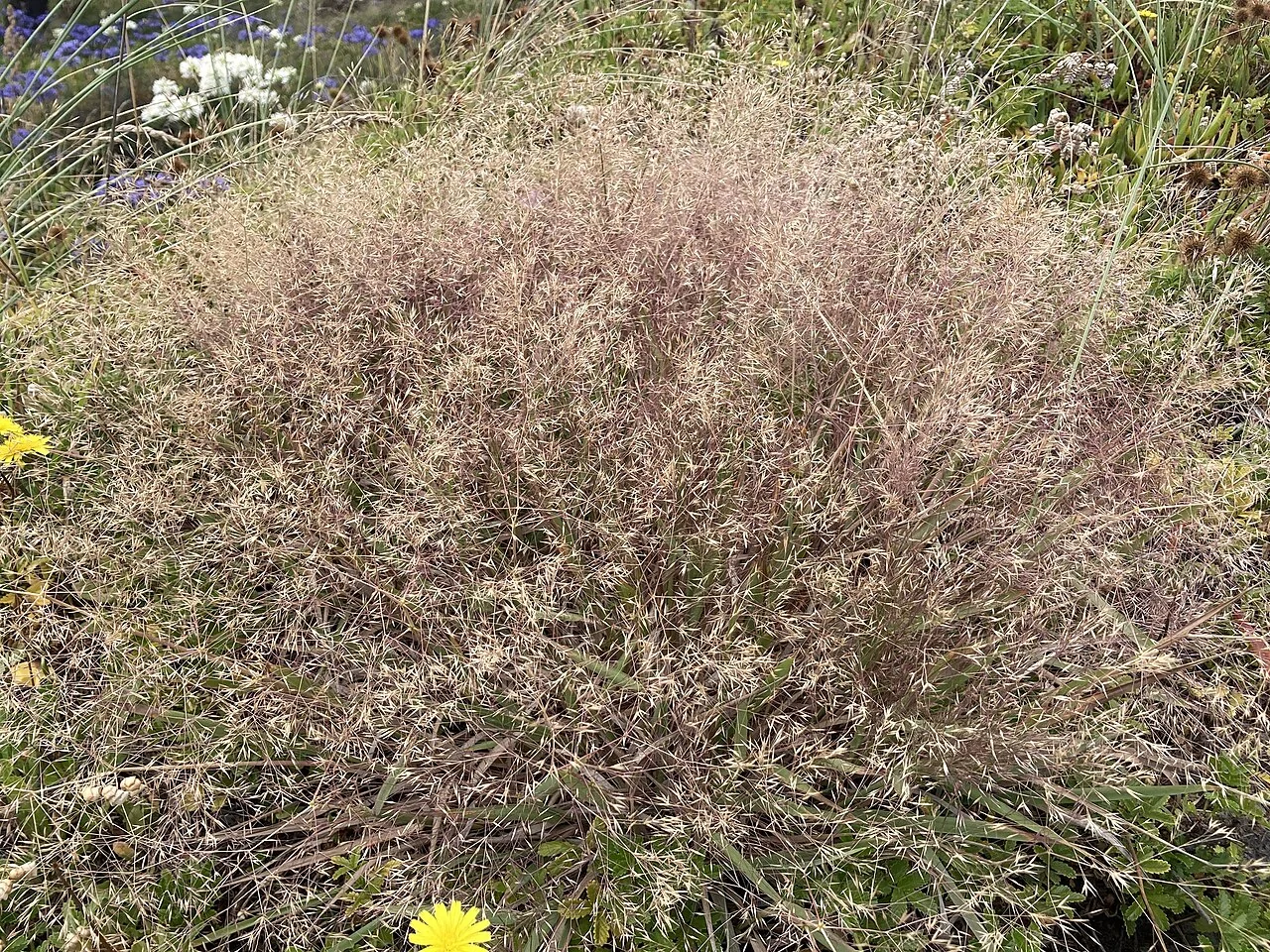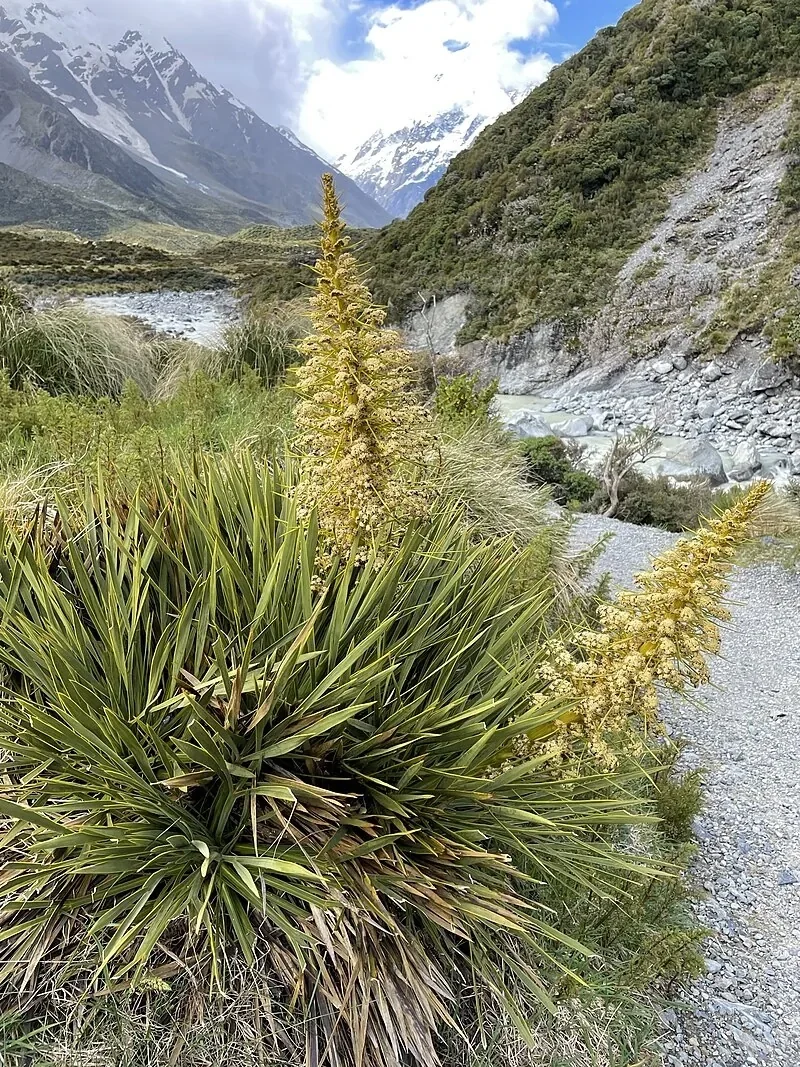
Coast Blowngrass
Lachnagrostis billardierei
Coast Blowngrass ( Lachnagrostis billardierei ) is a naturally elegant coastal grass of New Zealand foredunes and sandy flats. Its loose, bluish-green tussocks and delicate, wind-borne seed heads bring movement and texture to plantings while tolerating salt-laden winds, shifting sands, and summer drought. It is valued in restoration for sand binding and in gardens for its light, shimmering effect.

Plant Description
A short-lived to perennial, tufted grass forming loose mounds typically 30-60 cm tall, occasionally taller in deep, mobile sand. Leaves are fine, often slightly inrolled, bluish- to grey-green and flexible rather than harsh, giving a soft outline compared with the stiffer sand-binders it often grows with. The inflorescences are open, airy panicles that expand in summer; when mature, whole panicles can detach and tumble inland on the wind, an effective dispersal strategy that gives the group its common name of "blown-grasses". Culms are slender and wiry, helping the plant flex in strong onshore winds.
Quick Facts
| Scientific Name | Lachnagrostis Billardierei |
|---|---|
| Form | Loose, airy tussock grass |
| Height | 30-60 cm foliage; taller in flower |
| Spread | 30-60 cm clump; self-seeds on open sand |
| Light | Full sun; tolerates high wind and salt |
| Water | Low once established; drought tolerant |
| Water Needs | Low; drought tolerant once established |
| Frost Tolerance | Moderate; hardy in coastal areas |
| Salt Tolerance | High; excellent salt and wind tolerance |
| Growth Rate | Moderate; establishes well in first season |
| Lifespan | Short-lived to perennial; self-seeds readily |
| Hardiness | Coastal hardy; tolerates poor, sandy soils |
Climate Best Suited to
Coast Blowngrass thrives in coastal and exposed environments, demonstrating resilience to harsh conditions. It is well-suited to temperate oceanic climates with moderate temperatures, salt-laden air, and variable rainfall. It tolerates temperature fluctuations, from mild maritime conditions to cooler southern weather. Its natural distribution across New Zealand and temperate Australia highlights its adaptability, making it suitable for cultivation in most major New Zealand centers, especially coastal areas.
Regional Suitability
| City | Climate Suitability |
|---|---|
| Whangārei | Ideal |
| Auckland | Ideal |
| Hamilton | Ideal |
| Tauranga | Ideal |
| Rotorua | Ideal |
| Gisborne | Ideal |
| New Plymouth | Ideal |
| Napier | Ideal |
| Whanganui | Ideal |
| Palmerston North | Ideal |
| Wellington | Ideal |
| Nelson | Ideal |
| Christchurch | Ideal |
| Dunedin | Ideal |
| Invercargill | Ideal |
Natural Habitat
In Aotearoa New Zealand, Coast Blowngrass is characteristic of foredunes, backdunes, and sandy flats beside estuaries and coastal lagoons. It occupies semi-mobile sands where salt spray, wind, and periodic sand burial limit competition. Plants often weave among other dune specialists such as Spinifex sericeus and Ficinia spiralis , exploiting open patches created by storms and seasonal sand movement.
Plant Conservation
The species is presently listed as Not Threatened nationally, yet its habitat is locally pressured by dune stabilisation earthworks, off-road vehicle traffic, and invasive beach grasses. Using eco-sourced plants in restoration, controlling access on sensitive foredunes, and retaining natural sand mobility all help maintain viable populations and the dynamic processes they depend on.
How to Grow Coast Blowngrass
Coast Blowngrass is an excellent choice for challenging coastal conditions and provides natural movement in exposed garden settings. This hardy native grass requires minimal intervention once established, making it perfect for low-maintenance landscapes that need to withstand salt spray, wind, and drought.
Site Selection and Soil Preparation
Choose the sunniest, most exposed site available, as Coast Blowngrass thrives in full sun and windy conditions that would stress other plants. The soil must drain freely - heavy clay soils should be amended with coarse sand and grit to improve drainage. Sandy, low-fertility soils are ideal, mimicking the plant's natural foredune habitat. Avoid rich, fertilized soils which produce coarse, weak growth that lacks the fine, elegant character of wild populations.
Planting and Establishment
Plant in autumn or early spring when temperatures are moderate and natural rainfall can assist establishment. Space plants 50-70cm apart to allow natural clumping while providing good coverage. Water thoroughly after planting to settle soil around roots, then mulch lightly with shell grit or coarse sand rather than organic mulch, which retains too much moisture for this drought-adapted species.
Watering and Maintenance
Water regularly during the first growing season to establish a strong root system, then reduce to occasional deep watering during extended dry periods. Avoid frequent shallow watering which encourages surface rooting and reduces drought tolerance. The plant's natural response to dry conditions is to become more compact and blue-grey, enhancing its ornamental value.
Planting Guide
Best Planting Practices
On dunes, plant into natural hollows or the lee of low contour to reduce sand blasting. Water in to settle sand around roots, then mulch lightly with washed shell or coarse grit to reduce scouring. Space clumps 50-70 cm apart for a continuous, breathable cover that still allows sand movement between plants.
Ecosystem Notes
Loose tussocks slow surface winds and trap sand, subtly reshaping dune microtopography. The plant's seasonal panicles feed invertebrates and provide cover for coastal skinks and ground-nesting fauna. Because it tolerates periodic burial and exposure, it is a useful matrix species in dynamic restoration zones where rigid plants struggle.
Uses and Significance
In gardens, use Coast Blowngrass for movement and a light, seaside character in gravel gardens, sandy courts, and coastal borders. In restoration, it occupies semi-mobile sands between pioneer binders and more stable back- dune shrubland, helping to knit surfaces without halting natural sand drift.
Landscaping Ideas
For the lightest, most mobile look in gardens, avoid rich composts and irrigation once established. Lean conditions keep foliage fine and panicles extra-airy, enhancing the grass's signature shimmer in evening light.
Seasonal Care
Year-Round Maintenance
Minimal feeding is needed. In late winter, comb through clumps with gloved hands to remove spent leaves and old panicles. Avoid hard cutting to the crown; gentle grooming maintains the plant's delicate habit and quickly reveals fresh growth in spring.
Pruning and Maintenance
Trim only to tidy, never to a tight mound. Where plants lean after storms, re‑set by firming sand at the base rather than cutting back. Replace older clumps every few years in high‑energy sites to keep displays lively.
How to Grow Coast Blowngrass from Seed and Division
Coast Blowngrass offers excellent propagation opportunities through both seed collection and careful division of established clumps. Understanding the plant's natural reproductive cycles and habitat requirements is essential for successful cultivation and restoration work. This hardy coastal species has evolved sophisticated strategies for both sexual reproduction through wind-dispersed seed and vegetative expansion through rhizomatous growth.
Seed Collection and Processing
Collect seed from mature panicles during late summer to early autumn when the characteristic airy seed heads begin to detach naturally from parent plants. The best seed is obtained from plants growing in typical foredune conditions, as these specimens demonstrate genetic adaptation to coastal stresses. Clean seed thoroughly to remove chaff and debris, as foreign material can harbor fungal pathogens that compromise germination success. Store cleaned seed in paper envelopes in a cool, dry place and use within six months for optimal viability.
Seed Germination Techniques
Surface-sow fresh seed onto a gritty, free-draining propagation mix composed of equal parts river sand, pumice grit, and quality potting medium. Light aids germination significantly, so barely cover seeds with fine grit rather than burying them deeply. Maintain consistent moisture without waterlogging by misting regularly, and provide temperatures between 10-18°C for optimal germination conditions. Germination typically occurs within 2-4 weeks under ideal conditions, though some seeds may take up to 8 weeks to emerge. Once seedlings develop their first true leaves, prick out carefully to individual cell trays to encourage strong, fibrous root development.
Division and Establishment
Divide established clumps in autumn when soil moisture is naturally reliable but temperatures remain moderate, allowing roots to establish before winter dormancy. Carefully lift entire clumps and tease apart natural divisions, ensuring each section contains healthy roots and several growing points. Plant divisions immediately into pre-prepared sites with excellent drainage, spacing them 60-80cm apart to allow natural spreading. Water thoroughly after planting and maintain steady moisture through the first growing season until plants demonstrate strong establishment through new growth and natural drought tolerance.
Aftercare and Long-Term Success
Young plants require protection from strong winds and salt spray until their root systems fully establish, typically requiring 12-18 months in coastal conditions. Mulch lightly with shell grit or coarse sand rather than organic materials, which can retain excessive moisture around the crown. Monitor for establishment success by observing the development of the characteristic bluish-green foliage and airy growth habit. Established plants will begin producing their own seed heads within 2-3 years, contributing to natural regeneration and site colonization. Regular inspection during the establishment period allows early intervention if plants show signs of stress from drought, salt exposure, or competition from more aggressive species.
Pests and Diseases
Common Problems and Solutions
Generally free of serious problems in coastal settings. Crown rot can occur in heavy, waterlogged soils; avoid over‑watering and ensure sharp drainage. In sheltered, fertile inland gardens, occasional aphids may settle on soft spring growth - usually transient and controlled by predators.
Cultural Significance
Blown-grasses feature in the changing, wind-shaped character of many coastal landscapes. Retaining these dynamic systems - rather than fixing dunes in place - supports the coastal identity and biodiversity of local communities.
Bonus Tip
Expert Growing Advice
For the lightest, most mobile look in gardens, avoid rich composts and irrigation once established. Lean conditions keep foliage fine and panicles extra-airy, enhancing the grass's signature shimmer in evening light.







